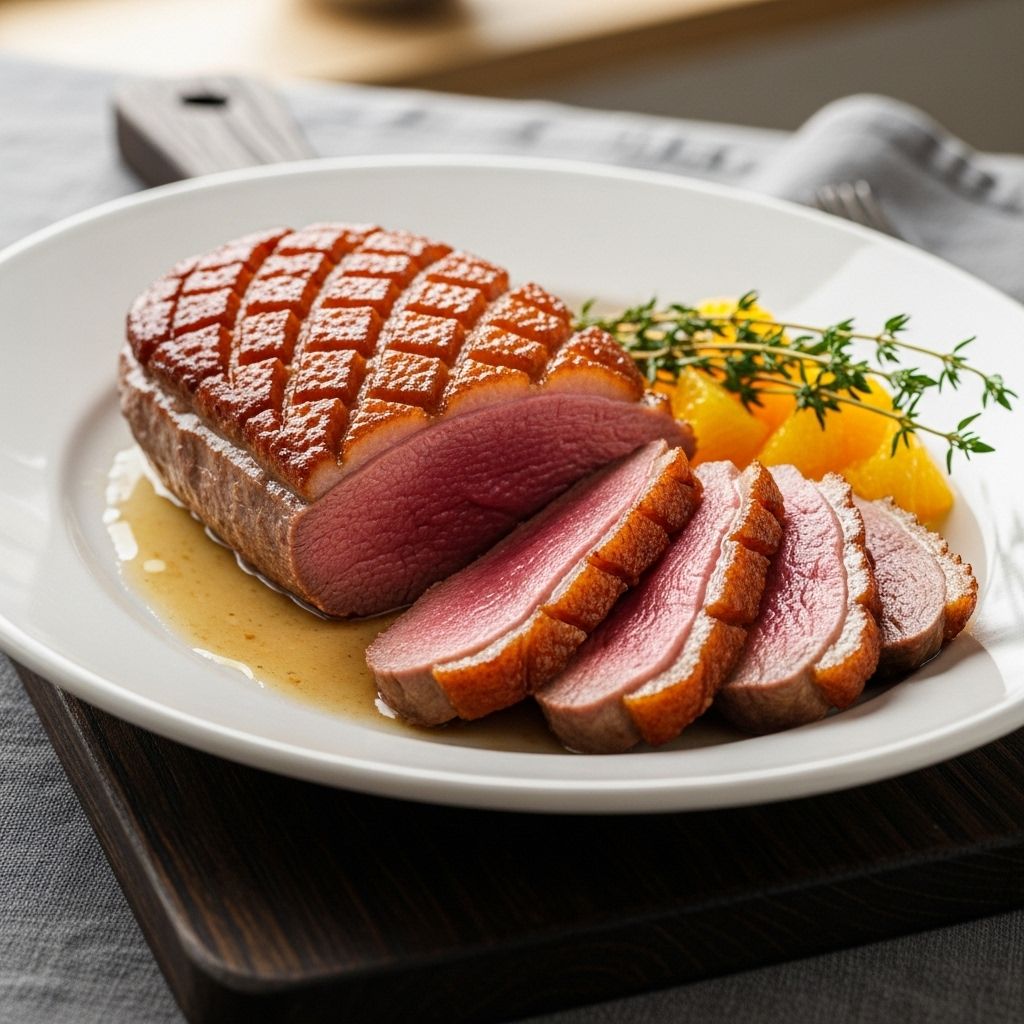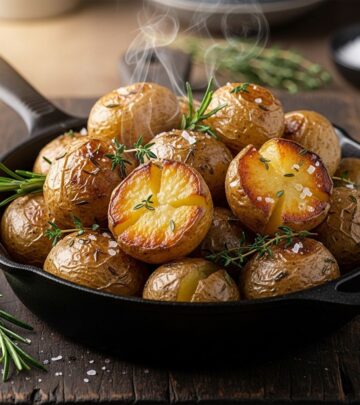Pan-Seared Duck Breast: The Ultimate Guide to Perfectly Cooked Duck
Master each step for succulent results and perfectly rendered exterior every time.

Pan-Seared Duck Breast: The Ultimate Guide
Pan-seared duck breast is a culinary delight, celebrated for its rich flavor, tender meat, and irresistible crunchy skin. When cooked properly, it’s a showstopper you can easily master at home. This guide dives deep into each stage of preparation, cooking, and serving duck breast, unveiling expert techniques and troubleshooting advice for restaurant-quality results every time.
Why Pan-Seared Duck Breast?
Duck breast stands out for its unique character: rich, rosy-red meat and a thick, fatty skin that crisps up beautifully with the right approach. Pan-searing maximizes this contrast between meat and crackling skin, producing a sensory experience that few other dishes offer. While beef steak is a classic for carnivores, duck breast delivers pronounced depth, a gamey undertone, and complex aroma that elevates it for special occasions and adventurous home cooks.
The Distinct Nature of Duck Meat
- Lush, moist, and densely flavored compared to chicken or turkey breast.
- Thicker fat cap: Enables luxurious texture and crispy skin.
- Should be cooked more like steak: Medium-rare or medium, never well-done.
Choosing Your Duck Breast
The quality of your finished dish starts with a good duck breast. Here’s what to look for:
- Type: Moulard (often found in stores, larger and fattier) or Pekin (smaller, leaner, mild flavor).
- Skin: Should be smooth, pale, and intact without blemishes.
- Meat: Bright color suggests freshness. Avoid grey or dull patches.
- Size: Uniform size helps with even cooking.
Pro tip: Many specialty stores or butchers sell high-quality duck breast, vacuum-sealed for freshness. Choose the freshest available for best results.
Preparation: Scoring and Seasoning
Proper preparation is key to crisp skin and juicy meat. Here’s how to set the stage before you cook:
1. Trimming Excess Fat
Duck breasts typically come with a thick layer of skin and fat. While desirable for texture, overly heavy fat can slow down rendering and impede crispness.
- Trim any large flaps of skin at the edges.
- Remove silver skin and sinew from the meat side if present.
2. Scoring the Skin
Scoring enables excess fat to render and skin to crisp.
- Use a very sharp knife.
- Score the skin in a crosshatch or diamond pattern, cutting just deep enough to breach the skin and fat, but not the meat.
- Space cuts about 1/2 inch apart.
Warning: Take care not to slice into the meat. Scoring too deep will cause juices to leak and hinder browning.
3. Seasoning
- Salt: Generously season both sides with coarse salt just before cooking for proper flavor and crispy skin.
- Pepper: Freshly ground black pepper adds aroma, but some cooks prefer adding after cooking to avoid burnt flavors.
- Optional aromatics: Try a pinch of five-spice or thyme for subtle complexity.
Cooking: Pan-Searing Duck Breast
Pan-searing is all about technique. Here’s a step-by-step breakdown for perfect results:
Step 1: Cold Pan Start
Unlike steak, duck breast benefits from starting in a cold nonstick or heavy skillet. This method enables gentle, gradual rendering, enhancing crispness without burning.
- Place scored, seasoned breasts skin-side down in a cold pan.
- No oil needed; the duck’s own fat will suffice.
- Set heat to medium-low.
Step 2: Render and Crisp the Skin
As the pan heats, fat will render out. The goal: deeply golden, paper-thin crispness.
- Allow breasts to cook undisturbed for 6-15 minutes, depending on thickness.
- Periodically spoon off excess rendered fat for other uses.
- Check progress by gently lifting the edge with tongs.
| Thickness | Time (Approx.) | Goal |
|---|---|---|
| Thin (< 1-inch) | 6-8 min | Crisp, golden skin; almost all fat rendered |
| Standard (1-1.5 inch) | 10-12 min | Deep brown, ultra-crispy, thin layer of fat left |
| Thick (>1.5 inch) | 12-15 min | Fully rendered, no pale patches, skin is snappy |
Step 3: Finish Cooking Meat Side
Once the skin is crisp, flip the breast and sear the meat side to finish:
- Raise heat to medium or medium-high for quick browning.
- Sear 1-2 minutes; the goal is gentle caramelization, not blackening.
- Internal temperature should read 130°F–135°F for medium-rare.
Step 4: Resting
Letting the duck breast rest after cooking is essential for juicy results.
- Transfer breasts to a plate, skin-side up.
- Tent loosely with foil, rest 5-10 minutes.
- This redistributes juices for moist meat.
Serving Suggestions
Duck breast’s robust flavor pairs well with both sweet and savory accompaniments. Here are classic and modern pairings to consider:
- Fruit Sauces: Cherry, orange, pomegranate, or blackberry reduction.
- Vegetable Sides: Roasted root vegetables, wilted greens, potato purée, lentils.
- Sauce Ideas: Balsamic glaze, red wine or port sauce, spiced honey.
- Grains and Starches: Wild rice, barley, or couscous complement the rich meat.
Slicing for Service
- Slice on the bias into 1/2-inch thick pieces for best appearance and tenderness.
- Arrange fanned slices over sauce or sides for dramatic presentation.
Troubleshooting Common Duck Breast Issues
If your duck breast isn’t turning out as crisp or juicy as you hoped, don’t worry. These simple fixes can help:
- Rubbery Skin: Failure to render fat thoroughly. Increase rendering time on first side; trim excess fat; avoid high heat early on.
- Tough, Chewy Meat: Overcooking is usually to blame. Use a thermometer; pull meat at 130–135°F.
- Soggy Skin after Resting: Never rest duck breast skin-side down; rest skin-side up to keep it crispy.
- Greasy Results: Spoon off rendered fat during cooking, reserve for sautéing vegetables or roasting potatoes.
Expert Tips for Pan-Seared Duck Breast
- Pat skin completely dry with paper towels before scoring and seasoning.
- Let seasoned duck sit uncovered in the fridge (ideally overnight) for ultra-crispy skin.
- Don’t overcrowd the pan: Too many breasts lower heat and steam skin.
- Use a splatter guard: Duck fat is notorious for popping as it renders.
- Save rendered duck fat: It’s prized for cooking potatoes, vegetables, or eggs.
With technique and attention to detail, you’ll turn out duck breasts with crisp skin and rosy, juicy centers every time.
Frequently Asked Questions (FAQs)
Q: How do I know when the duck breast is done?
A: Use an instant-read thermometer. Pull the duck breast from the pan at 130–135°F for medium-rare. Remember, the temperature will rise a few degrees as it rests.
Q: Why is my duck skin rubbery and not crisp?
A: This usually means not enough fat was rendered out. Make sure to start skin-side down in a cold skillet and let the rendering process happen slowly over moderate heat. Spoon off excess fat as needed.
Q: Can I add spices or marinades?
A: Absolutely! While classic preparation uses just salt and pepper, you can rub the meat side with five-spice, smoked paprika, or dried herbs for added flavor. Avoid sweet marinades directly on the skin—they can burn during searing.
Q: Is duck breast safe to eat medium-rare?
A: Yes. Unlike poultry legs and wings, duck breast is safe to consume medium-rare, much like beef steak. This ensures tenderness and full flavor.
Q: What’s the best wine pairing?
A: Rich red wines such as Pinot Noir, Merlot, or Syrah pair beautifully with duck breast. Fruity notes in the wine complement the meat’s gamey edge and crisp skin.
Conclusion
Pan-seared duck breast is a signature dish that balances culinary precision with rewarding flavor and texture. Crispy skin, succulent meat, and a world of possible accompaniments make it a shining centerpiece for home cooks eager to elevate their repertoire. With this ultimate guide, you’re equipped to buy, prep, cook, slice, and serve duck breast with the confidence of a professional chef.
Essential Pan-Seared Duck Breast Recipe
- Prep time: 10 minutes
- Cook time: 15-20 minutes
- Resting time: 5-10 minutes
- Serves: 2
Ingredients:
- 2 Moulard or Pekin duck breasts
- Kosher salt
- Black pepper
- Optional: fresh herbs, five-spice, or citrus zest
Instructions:
- Trim excess fat and silver skin. Pat skin dry.
- Score skin in a diamond pattern, taking care not to cut the meat.
- Season both sides generously with salt and pepper.
- Lay duck breasts skin-side down in a cold pan. Set heat to medium-low.
- Render and crisp skin, spooning off fat as it accumulates.
- Flip breasts and sear meat side for 1-2 minutes.
- Check temperature; remove at 130–135°F.
- Rest 5-10 minutes, skin-side up.
- Slice on the bias and serve with desired accompaniments.
Storage and Reuse Tips
- Store leftover duck breast in the refrigerator up to 3 days.
- Reheat gently in a skillet, skin-side down first for a few minutes, to restore crispness.
- Use extra rendered duck fat to roast potatoes or sauté veggies — it’s a prized ingredient!
Nutrition Information (Per 6 oz. Serving)
| Calories | Protein | Fat | Carbohydrates |
|---|---|---|---|
| 330 | 30g | 20g | 0g |
Duck breast provides healthy fats, protein, and important minerals. Pair with a balanced side for a nutritious, satisfying meal.
Final Tips for Duck Breast Perfection
- Practice makes perfect: The more you cook duck, the more your results will shine.
- Don’t skip the rest: A brief rest time after searing is crucial to juiciness.
- Experiment with sauces and sides for variety.
- Always slice on a sharp bias for the prettiest presentation.
With the right knowledge and a bit of patience, pan-seared duck breast can be the star of your next special dinner. Master the techniques above and enjoy restaurant-quality duck right from your own kitchen!
References
Read full bio of Sneha Tete












